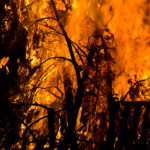 Southern Nevadans are following the news of Mt. Charleston’s Carpenter 1 fire with concern and sadness. Many have friends and family either involved in the firefighting effort or with property in harm’s way.
Southern Nevadans are following the news of Mt. Charleston’s Carpenter 1 fire with concern and sadness. Many have friends and family either involved in the firefighting effort or with property in harm’s way.
As the battle continues, we should all hope for a successful outcome of these efforts rather than seek to place blame where it doesn’t belong.
Unfortunately, this is exactly what Commissioner Tom Collins has done with his comments as reported by Jon Ralston:
The latest from [Tom Collins,] the county commissioner and potential lieutenant governor candidate: Enviros and forestry service officials are responsible for the awful Mt. Charleston fire. If only cows were still allowed to roam there, he suggested.
Oh, yes. He did.
In response to a county internal update on the fire Saturday, Collins responded to the email (that I have obtained): “I remember when Owens , Young , Greenoughs, Adams, Dawsons, and others grazed these areas. We never had this size of uncontrolled fires. God curse the tree huggers and the NFS”
Um, what?
Warming trends and drought in Nevada leave our state vulnerable to fire. Fire, and its behavior, is first and foremost a function of weather. This year in Southern Nevada we have only received a quarter of our normal precipitation. This, coupled with dry winds and record-breaking temperatures, has further desiccated the already dry vegetation in the Spring Mountains, increasing the risk of fire. Unfortunately, these trends will likely continue to leave our state at risk for catastrophic fires due to the effects of climate change.
The majority of the Carpenter 1 Fire is burning in very steep rough terrain, which makes it difficult to get fire crews into those areas and could put them at risk. That is why firefighters are making good use of the seven helicopters, four heavy air tankers, and one Very Large Air Tanker (VLAT), to help fight this fire in the steep terrain.
This fire was started at high elevation by a lightning strike. It is preposterous to blame this fire on land management decisions related to roads, since many areas of this burn have never contained roads.
Further, this extremely steep terrain would make grazing impossible for cows. Though cows did at one time graze on BLM and USFS-managed lands in the area of the Spring Mountains, they grazed at lower elevations that contained milder terrain and grasses. They did not graze at high elevations where the pinion and juniper meet the bristlecone pine. Most of the Carpenter 1 fire is above 7,500 feet, above where public lands grazing formerly occurred.
We in the conservation community fully support all of the firefighters and their management efforts to control this fire and protect the homes and resources of the Spring Mountains. We are dismayed that an elected official would use this tragedy to trot out the tired canard that responsible public lands management is somehow to blame for wildland fires.
Our hearts go out to the residents and families impacted by this fire.
Scot Rutledge, Executive Director
Nevada Conservation League
